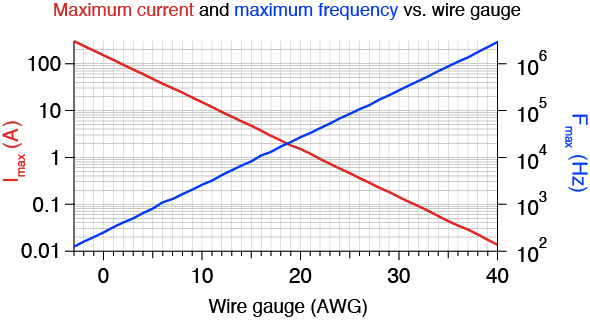Wire gauge frequency ratings
As previously noted, homemade cables are to be avoided. However, stock cables are not always up to spec. For example, if one wants to drive stepper motors using a 9-pin serial cable, are the individual conductors able to carry the 1 A of current required? What about high frequencies over repurposed speaker cables?
The chart above (larger version) should help you decide what gauge of wire to look for in a particular application. Note that these are relatively conservative engineering specs, so in practice you can get away with underspec’ing a bit.
The maximum current is the current that, if sustained, won’t result in too much heating. The maximum frequency is the signal frequency at which there is 100% skin depth— i.e., the entire cross section of the wire is carrying the signal. At frequencies higher than this, the effective resistance of the wire increases.
To answer to the above questions: Yes, a 9-pin serial cable will work fine for driving steppers if the duty cycle is low (i.e., the stepper motors are typically not moving). Get a heavier guage if you can (e.g., 20 or 22 AWG), but since the currents are fairly brief the wires won’t heat up much even if you underspec them. However, with high frequencies through speaker cables, there might be problems. Even with 1 MHz signals through 18 AWG wire, there will be significant signal degredation.
Recently I needed a 3.5 mm TRS (tip-ring-sleeve, aka 3-conductor) phono cable that would carry fairly high sustained currents. Typically these types of cables are used to plug iPods and similar devices into the Aux inputs of car and home stereos. In that application, fairly light gauge wire is ideal since the currents are small. However, I was able to find a heavier gauge cable assembly from an audiophile shop.
Data source file (tab-delimited text, note that gauges 00, 000, 0000 are recorded as -1, -2, -3, to get the chart to plot properly)
via

If I understand the graph correctly and I want to choose an wire AWG for supertweeter speakers with a range of 15kHz to 100kHz, it looks like I should use something larger than 25 gauge…say 20 or 22 AWG?
Do I understand correctly?
Other direction– to cover out to 100kHz, 25 gauge should work.
>25 gauge (e.g., 26 or 28 gauge) will still work too.
However, if you need to pass >500 mA, then you might need thicker wire.